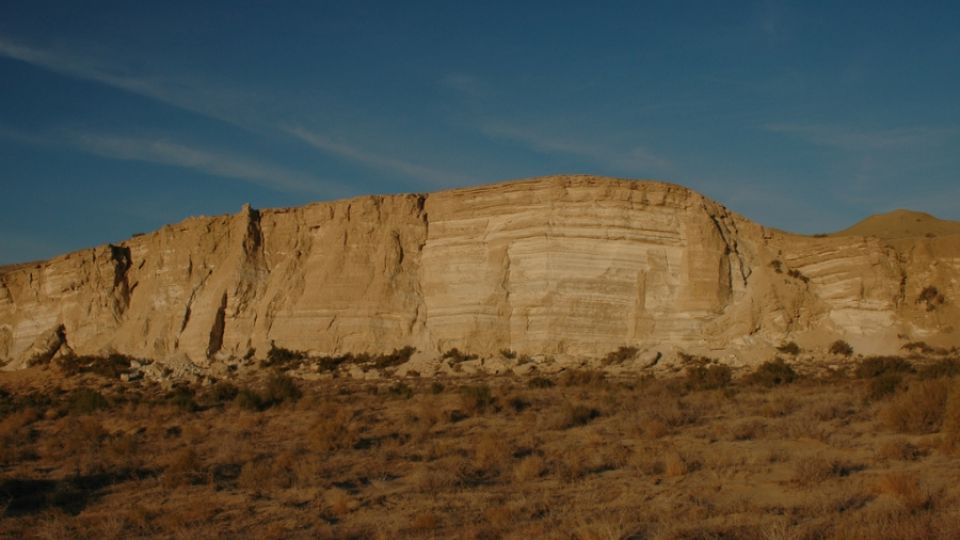Mangystau Region could soon become a popular spot on the global tourism map. The relevant international body examines the possibility of inscribing the unique Ustyurt Nature Reserve on the UNESCO World Heritage list. At the same time, the fear is that splendid landscapes and important habitats of antelopes can be lost forever. State oil company – KazMunaiGas – is pushing for the permission to extract gas from the new Khansu gas fields at the very edge of the nature reserve (1). Non-governmental organisations and experts from several countries are sounding the alarm: once the gas field is opened, future generations will lose any opportunity to benefit from ecotourism. Citizens can support nature conservation by signing a petition (2).
“Impacts of potential Khansu gas field development on the ecosystems will be catastrophic,” explains Zhaskayrat Nurmukhambetov, the deputy director of the Ustyurt Nature Reserve. “Due to the powerful disruption, at least the southern half of the reserve will become uninhabitable for a number of species enlisted in the Red Book, such as arkar, goitered gazelle, saker falcon, golden eagle, vulture, Eurasian eagle owl, or chlamydotis. Of special concern is the fact that virtually all the lands around the Ustyurt Plateau are ‘booked’ for hydrocarbons extraction by either state or private companies. Their opening would entirely destroy important habitats,” the deputy director says.
KazMunaiGas argues that the Khansu gas field will bring about 300 new jobs, but environmentalists have a different opinion. “Many new jobs will be occupied by foreigners. Only few ancillary works will remain for local citizens at best,” says Kirill Osin, the director of non-governmental organization Eco Mangystau.
“The government admits that we have 70 thousand people in the city of Zhanaozen dependent on the oil extraction, but the reserves will soon run out. It is becoming very clear that a few dozen temporary jobs at the new fields cannot help. We must develop a new long-term economic strategy for Mangystau based on our natural heritage and tourism that can secure future for next generations instead of devastating our land. In a time when many areas are polluted by previous or current industrial activity, the safe and clean steppe around Ustyurt is also an ideal place for keeping livestock,” Osin adds.
Moreover, the compromise exists. Environmentalists suggest developing Samtyr gas fields, located to the East from Ustyurt Plateau far enough not to affect the valuable ecosystem.
The experts of environmental organizations Eco Mangystau, Eco Museum and CINEST (Karaganda), Dront (Russia), Arnika (the Czech Republic), and NABU (Germany) organize this week's series of events to raise public awareness in Mangystau and convince the authorities that further extraction is not a strategy of sustainable development. Citizens can support this effort by signing a petition at one of the events or on-line at www.ecocitizens.kz.
The nature reserve was established in 1984 on a territory of 223 thousand hectares to protect the breath-taking beauty and unique desert landscapes of Ustyurt Plateau with its canyons and crevices. It is a key habitat for a number of Red Book species and the only candidate for UNESCO World Heritage status in the Mangystau Region.
Notes for editors:
1) More information on Ustyurt Nature Reserve and its threat can be found in the on-line map of environmental hot spots of Kazakhstan (in Russian): http://ecocitizens.kz/hotspots/vpadina-karyn-zharyk
2) People can join the petition – open letter to the president Nursultan Nazarbayev – to save Ustyurt on-line at: http://ecocitizens.kz/petition
The experts of environmental organizations Eco Mangystau, Eco Museum and CINEST (Karaganda), Dront (Russia), Arnika (the Czech Republic), and NABU (Germany) organize this week's series of events to raise public awareness in Mangystau and convince the authorities that further extraction is not a strategy of sustainable development. Citizens can support this effort by signing a petition at one of the events or on-line at www.ecocitizens.kz.
The nature reserve was established in 1984 on a territory of 223 thousand hectares to protect the breath-taking beauty and unique desert landscapes of Ustyurt Plateau with its canyons and crevices. It is a key habitat for a number of Red Book species and the only candidate for UNESCO World Heritage status in the Mangystau Region.
For more information, please contact:
Jan Vavra (Arnika): via email: This email address is being protected from spambots. You need JavaScript enabled to view it., mobile +420 606 727 942, or Kirill Osin (Eco Mangystau), via email: This email address is being protected from spambots. You need JavaScript enabled to view it., mobile: +7 701 415 3161, or Elnara Bainazarova, Press and Information Officer at the EU Delegation to Kazakhstan, via e-mail: This email address is being protected from spambots. You need JavaScript enabled to view it., tel: +7 (7172) 97-11-48







